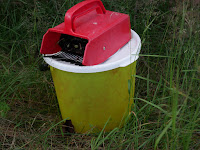Couple years ago I found Connected Learning group's research papers and noticed that what we have some similarities what we had made here in Finland with students. I'm really impressed that work what you all have done. I have learned a lot. I found CLMOOC from Twitter and I was little bit uncertain could I join. I'm glad I have been here. Even if my English is not good, I have got a lot. I had not time to read everything but I will come back and explore them later. You guys are so skillful and you have made so many incredible things and shared those all. I have got new ideas what I will try with students. Thank you all. My own interest is always think how new things can be part of teaching and learning at school. Other big interest is inquiry with students and models and theory about that. I am so grateful your all comments about my posts of inquiry based learning and my papers which I shared.
I enjoyed last make cycle, that was familiar topic for me. We have nice national parks here too, I apologize, I did not presented those to you. But I promise, if someone would like to come to Finland, I will tell and maybe show you some of those. Especially if you are interested in Lake Finland area and our nice forest and ridge areas. I took freedom in this cycle to focus more immediate surroundings, because I think it is our big resource of learning here in Finland, but we should develop models how to connect it deeper for learning.
Thank you all CLMOOC friends and especially you who are responded this CLMOOC, those who are kept some kind of system here, when we had opportunity to hanging out, geeking around and messing out here how we liked ;).
- I am not good with names, so I don't name any of you personally, Thank you all.
Finally, I would like to share one more figure. I took freedom to connect photos of our learning projects to J-S Brown's thoughts about learning and imagination. I think this could one way to think learning. I think, my CLMOOC could be like this kind of attempt of deep tinkering with you my CLMOOC friend.
see J-S Brown (2012) CULTIVATING THE ENTREPRENEURIAL LEARNER THE 21ST CENTURY





















 This is my view of un-introduction.
This is my view of un-introduction.